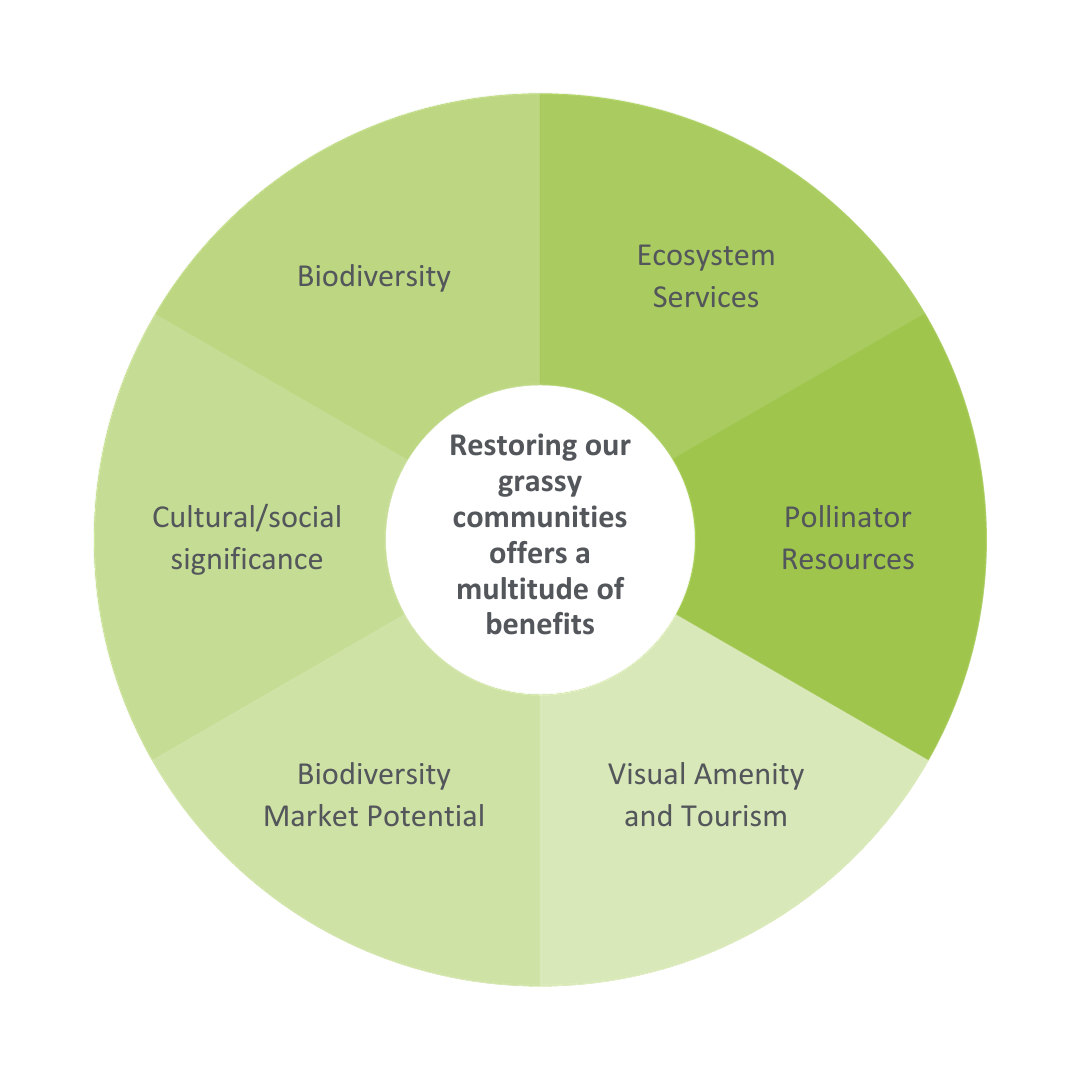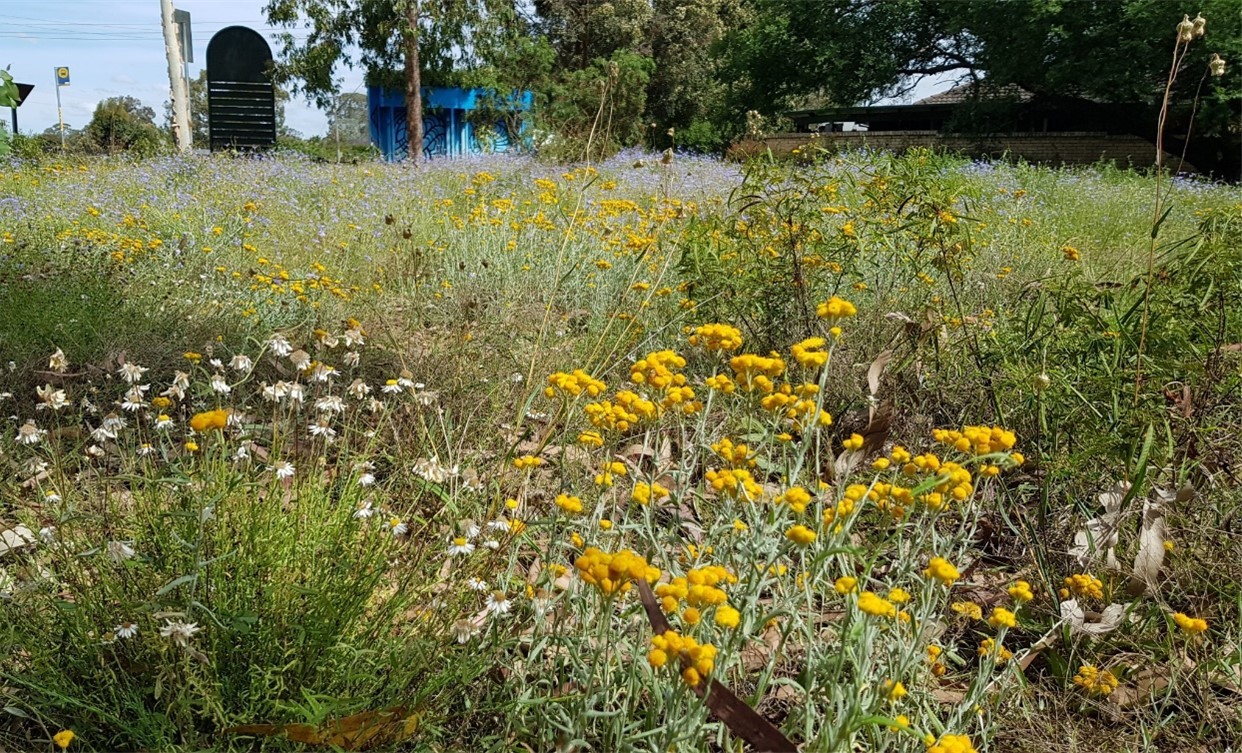Ecological restoration: sometimes it’s better to not plant a tree. A call to recognise and restore Australia's Native Grasslands and Grassy Woodlands.
Tuesday, 24 October, 2023
Native grasslands and grassy woodlands are biologically diverse ecosystems that once stretched across vast expanses of the continent, teeming with diverse plant and animal life. Today, they are among Australia's most threatened environments. The good news is that it is not too late to start restoration.
What happened to our native grasslands and grassy woodlands?
Historically, these grassy communities were managed by Aboriginal Australians for their food, cultural, and resource value. They were maintained in states that were treeless or sparsely treed because of the rich diversity of flora, including annual and perennial grasses, colourful wildflowers (forbs) and fauna that thrived in these spaces. Often occurring in areas of decent rainfall and soil, the timing and intensity of fires was managed to keep them in this open structure. This made them immediately attractive to early settler pastoralists and latter for cropping agriculture. Both had devastating effects on the native species. Overgrazing, the competitive effects of introduced exotic species, disturbed soils from livestock and cultivation, and the favouring of exotic flora species over natives through the elevation of soil nutrient levels from fertilisation all combined to eradicate native grasslands and grassy woodlands. As a result, they are now among Australia’s most threatened communities. For this reason, restoring these ecosystems is vital to prevent further loss and extinction.

Grassy woodland from north-western NSW.
Why aren’t we seeing more efforts to restore grasslands?
Despite the benefits and success stories, grassland restoration in Australia has yet to be widely applied. This has meant that to date, grassland restoration projects have typically only been undertaken at 1 to 20ha scales, partly because of scepticism about its feasibility from within the sector, but primarily because most forms of funding for restoration in Australia have been for the planting of trees and shrubs rather than restoring landscapes to their original diverse forms. This is still the case with most Offset and carbon-type projects. More recently the setting of grand global-scale restoration targets under the UN-Decade for Restoration has raised more concerns that governments will fund increased afforestation via tree plantings in regions that are or were once native grasslands.
For some in the restoration sector, the lack of confidence around the feasibility of restoring grasslands to their reference state stems from a belief that only ‘nature’ can achieve this type of ecosystem complexity. Hence there is now an almost total focus on ‘conservation’ by scientists and regulators in Australia- even though in Australia’s most cleared arable landscapes, there is precious little left to conserve. It is here in these regions where ‘restoration’ is most needed. Importantly, studies of ecological restoration in Australia, the US, and Europe have proven that ecological restoration is entirely feasible and that grassy communities can indeed be restored to high-diversity states in those landscapes where they are now almost absent.
‘It is feasible to restore Australia's native grasslands, and it is our responsibility to do so.’
Dr Paul Gibson-Roy

Restoring our grassy communities offers a multitude of benefits:
Biodiversity: High-quality grasslands support a remarkably extensive diversity of species, aiding in addressing our critical loss of biodiversity.
Ecosystem Services: Grasslands store carbon (mostly below ground), provide habitat for beneficial insects that can control problem pests in farming systems, stabilise soils, and reduce erosion.
Pollinator Resources: Wildflowers in diverse grasslands are vital for pollinators, essential for agriculture.
Visual Amenity and Tourism: Restored ‘wildflower trails’ can attract tourists to rural areas, boosting local economies. This has been proven in the US, with the restoration of wildflowers alongside roadsides drawing significant tourism revenue to rural areas.
Biodiversity Market Potential: With biodiversity markets on the horizon, landholders may generate income through tradable biodiversity certificates.
Cultural/social significance: Restored grasslands can contain many species that are culturally significant to indigenous Australians (e.g., foods, medicine and spiritual). They also assist in helping all people develop connections, recognition and affinity with the native flora of their region.

Restored ‘wild-flower rich’ native grassland in an urban setting (Camden NSW)
The Restoration Process:
Successful grassland restoration involves several key elements:
Access to Land: Access to land is necessary for restoration efforts.
Market Incentives: Funding mechanisms, whether regulatory or private, are crucial for supporting or incentivizing restoration projects.
Sector Capacity: Recent sector surveys have shown the capacity of Australian restoration sector to undertake high diversity landscape scale restoration is extremely limited – a shift in government support for high diversity restoration (as opposed to simplistic tree plantings) is required to boost sector capacity,
Native Seed: Access to diverse, high-quality native seeds at a reasonable cost is essential.
Site Preparation Knowledge: Specialised knowledge is needed for effective site preparation, dealing with factors like weed seed banks and soil nutrients.
Specialised Equipment: Restoration often requires specialised equipment for tasks such as harvesting, processing, the storing and sowing of native seeds.
Maintenance Knowledge: Ongoing maintenance, including bushfire regime knowledge and control, ensures the preservation of grassy communities' desired state and composition.
Who Should Be Interested?
Native grassy communities are of importance from a regulatory point of view to several sectors, including:
- Government Environmental Agencies
- Natural Resource Managers
- Local Government
- Road and Rail Authorities
- Parks Managers
- Farmers
- Miners
- Developers
- Urban Planners
- Bushfire planners
- Community, Indigenous, and Environmental Groups
They are also relevant to community, indigenous and environmental groups
Examples of Success
There have been several successful restorations of grassland and grassy woodland in Australia over the past two decades. At relatively scales they developed and trialled novel approaches such as using soil manipulations to treat weed and nutrient issues, employing cultivated seed production systems to secure seed resources, developed specialised seed equipment and trialled various management approaches to preserve or enhance community structure (e.g., cool burns, slash and bale, timed grazing).
Location: Roadsides in Wickliffe and Geelong, Victoria
Results: As an example of success, a per reviewed paper focussed on two restored roadside grasslands on the Glenelg Highway in western Victoria provided clear evidence of the success of these approaches with both restorations almost indiscernible from nearby high-quality remnant grasslands (Gibson-Roy and Carland 2023). Close monitoring over a 15-year period showing that native diversity had continued to increase over time and that (importantly) weed presence was negligible, demonstrating the resilience of these restored communities. Additionally, these projects also proved cost-effective and dramatically reduced fire fuel load risk (in comparison to weed dominated roadsides) which is a major issue Australia’s fire prone landscapes.

Restored roadside grassland (Wickliffe VIC)

Restored grassland on farmland (Geelong VIC)
Other examples of Australian success have been documented where restorations have occurred on farmlands, public lands and in urban landscapes (e.g., Gibson-Roy & Delpratt 2015, Cuneo et al. 2018).
Inspiration from the United States
For clearer examples of success, we can look to the United States where large-scale, high-quality grassland and woodland restoration projects of large scale and quality are commonplace along roadsides, farms and in urban areas (Gibson-Roy 2018). Government support, through strong agri-environmental programs, and financial markets for restoration have driven this success.
Call to Action
Restoring Australia's native grasslands and grassy woodlands is a long overdue and a clear necessity. These ecosystems must be reintegrated into our agricultural landscapes, transport corridors, and urban areas to restore our native biodiversity. With a strong commitment from regulators, the environmental sector and the broader community and through the establishment of suitable legislation, policy and programs, we can provide the incentives and momentum required to reverse the damage done over such a long period and to finally begin halting and reversing grassland loss through landscape scale ecological restoration.
To learn more about reviving these critical ecosystems, contact us for a discussion.
Manager, Restoration Ecology and Land Management Andrew Whitford, AndrewW@ecoaus.com.au
Senior Botanist, Ecologist Gordon Patrick, GordonP@ecoaus.com.au
Suggested Reading:
Ecological Restoration – Moving Forward with Lessons Learned. 2023. Eds. Singarayer F., Paul Gibson-Roy, P., Dixon WD., Broadhurst L. Publisher - Springer Nature Switzerland AG International. ISBN: 978-3-031-25411-6.
Gibson-Roy, P., and Carland, F. 2023. Restored roadside grasslands provide an exciting template for road network conservation. Ecological Management and Restoration. 23:3. doi: 10.1111/emr.12571
Gibson-Roy. 2022. Australian Grassy Community Restoration: Recognising what is achievable and charting a way forward. Ecological Management and Restoration.23:1. 10-24.
Pedrini, S., Gibson-Roy, P., Trivedi, C., Candido, G., Hardwick, K., Shaw, N., Frischie, S., Laverack, G., Dixon, K. 2020. Collection and production of native seeds for ecological restoration. Restoration Ecology. 29 April 2020. https://doi.org/10.1111/rec.13190
Hancock, N., Gibson-Roy, P., Driver, M. and Broadhurst, L. 2020. The Australian Native Seed Sector Survey Report. Australian Network for Plant Conservation, Canberra.
Gibson-Roy, P & Delpratt, J. 2015. The Restoration of Native Grasslands in Land of Sweeping Plains – managing and restoring the native grassland of south-eastern Australia. Eds, Williams, N. Marshall, A. Morgan, J. CSIRO Publishing. 331-389.
